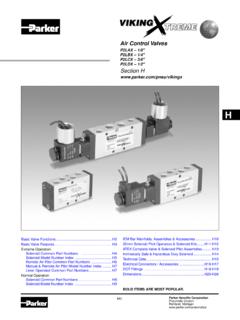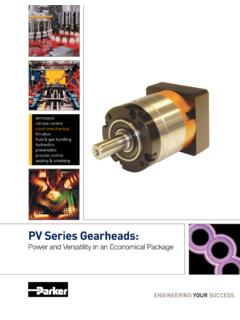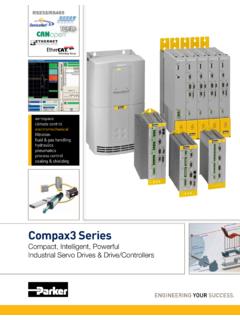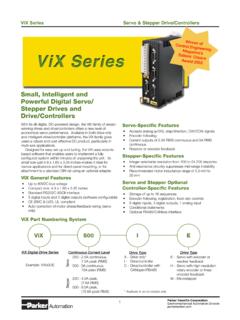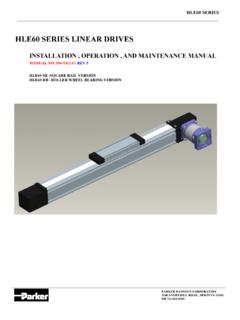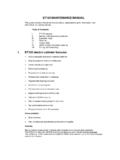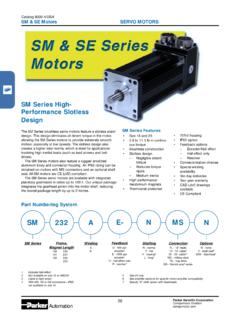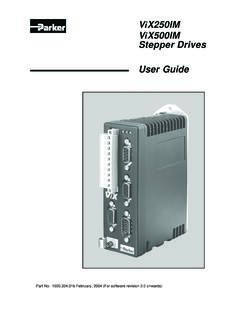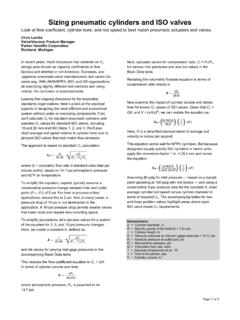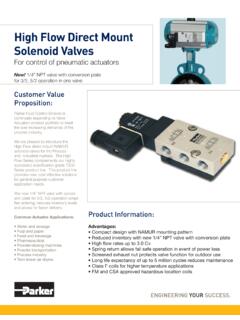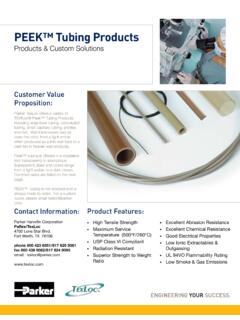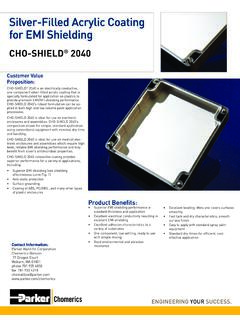Transcription of Comparing AC Induction with Permanent Magnet motors in ...
1 parker Hannifin 2013. Comparing AC Induction with Permanent Magnet motors in hybrid vehicles and the impact on the value proposition Jay W. Schultz and Steve Huard, PhD. EMN Division Automation Group 5500 Business Park Drive Rohnert Park, CA 94928. Keywords: (hybrid vehicles, EV, HEV, drivetrain, powertrain, electric motors , PMAC, drive cycle). Introduction In 2015, the high side projection is nearly $ per gallon while the low side is about 1. The Need $ per gallon. The gap between the two increases from $1 per gallon in 2015 to $2 per In the recent years, vehicle OEMs have been gallon by 2029. faced with the challenge to increase the efficiency of their vehicles. These challenges This increase is largely fueled by an ever stem from soaring fuel prices, government increasing demand in oil for transportation.
2 Regulation mandating increased fuel The following chart shows the global increase economy, laws requiring reduced greenhouse in commercial transportation fuel needs: gasses and customers demanding productivity gains on the vehicles. Fuel prices: The following chart from the California Energy Commission shows the projections for diesel fuel over the next 17. years. Figure 2: Commercial transportation demand by market (source: ExxonMobil, 2012 The Outlook for Energy: A view to 2040, pg 18). Figurer 1 High and Low Nominal Diesel Prices (source: California Energy Commission, TRANSPORTATION FUEL. PRICE AND DEMAND FORECASTS: Inputs and Methods for the 2009 Integrated Energy Policy Report, pg 16). Copyright 2013 to the present, parker Hannifin Corporation Page 1. with the global demand increasing and rising can impact the overall efficiency of the costs of diesel fuel a real probability, OEMs vehicle.
3 Are forced to plan for vehicle platforms that Suppliers see this need and are designing can offer their customers relief from these and manufacturing more efficient building rising costs. blocks for the many different applications on vehicles. Government Regulations: In addition to the economic impact of rising fuels, the federal Advanced Technologies: Another way to government and local governments are improve efficiency is to utilize alternative, or imposing strict regulations for vehicle advanced, technologies and radically manufactures. challenge the way vehicle control has been done. These regulations are primarily focused on reducing greenhouse gasses, anti-idling laws Engine manufactures are focusing on and higher efficiency. incorporating new technology into their diesel products.
4 Natural gas engines have become a viable solution for clean operation. Hybrid Productivity: At the same time as OEMs are vehicles are also starting to emerge on a reducing fuel consumption and meeting number of differing platforms from cars, government regulations, they are able to use trucks, and work boats to construction some of these requirements to improve the equipment and agricultural vehicles. productivity or performance of the vehicles. The hybrid technology used in the powertrain Depending on the OEM and specific vehicle, comes in two forms, hydraulic and electric. these might include: improved system response, more controllable, optimized power 3. The HEV Hybrid Electric Vehicle distribution and safety. HEVs are most recognized on the streets in 2. Increasing Efficiency passenger cars such as the Prius.
5 However, similar adaptations of this technology have Vehicle efficiency can be increased in migrated into many other vehicles. differing ways: Operator behavior, components specified and advanced Powertrain: The Prius incorporates hybrid technologies, such as hybrids. electric technology in the powertrain. The electric traction system delivers power to the Operator Behavior: This is likely the most cost wheels helping to propel the car when the effective and immediately available way to engine is least efficient. This is typically impact fuel costs and vehicle efficiency. But during acceleration. is, perhaps, one of the most challenging to effectively implement. The fleets must invest This same concept can be used by OEMs time and training to ensure operators building vehicles in a number of other understand how their behavior can impact markets.
6 This can help achieve the efficiency costs. Once done, ensuring that operators and emissions standards they are facing in meet the metrics is difficult. the coming years. Components Specified: Vehicle OEMs can Hydraulic Implements: Many vehicles such as dig into their existing design and optimize the work trucks and construction equipment components a bit more effectively. require hydraulics to operate the implements. Understanding the efficiency over the range On a vehicle, the power to run these of operation from pumps to engines and even implements is typically generated by an much smaller, less significant, components Copyright 2013 to the present, parker Hannifin Corporation Page 2. internal combustion engine (ICE) flows from the generator into the battery pack mechanically coupled to a hydraulic pump.
7 (4). This is the main process to charge the battery pack to store energy for later use by In a similar manner that electric systems are the powertrain or the hydraulics. used in the powertrain of passenger cars, OEMs are seeing that increased engine As the operator steps on the accelerator in efficiency and fuel savings can be realized by the vehicle, or adjusts the joystick to move a electrically powering the hydraulic pumps. hydraulic actuator, a command signal is sent to the motor controller (5). The stored energy The electric systems that are used to power from the battery pack flows through the motor both the powertrain and implements boil down controller into the electric motor (6). The to three major components: battery packs, motor converts this electric energy to rotary power inverters and electric energy by output torque at a particular RPM.
8 motors /generators. This power is delivered to the axle and wheels (7) which start the vehicle moving. Or 4. Major Electric Components on HEVs it is delivered to the hydraulic pump (8) to build pressure and allow the operator to move The following diagram shows the HEV the implement. system's major components: While there are differences in batteries and power electronics that can impact the system efficiency, the focus of the next section will be on the electric motor and its impact on the efficiency of the system. Implementation Electric motors Finite element analysis programs for magnetic Figure 3: Major electric hybrid components for series hybrid analysis continue to advance with faster and (powertrain) and electro-hydraulic implements (source: Mobile more sophisticated features.)
9 Hundreds, even Inverters and motors catalog, pg 4-5, parker Hannifin thousands of design scenarios can be run in Corporation). order to optimize and compare design trade- offs. 1. Internal combustion engine (ICE). 2. Electric generator When a vehicle OEM has decided to move 3. Generator controller forward with an electric hybrid program, there 4. Battery pack are two major choices for electric motors : 5. Motor controller Induction motors (IM) and Permanent Magnet 6. Electric Motor AC (PMAC) motors . 7. Axle/Wheel assembly (powertrain). 8. Hydraulic pump (EHA/ePump). with that in mind, a finite element program is used in order to compare the performance of The ICE (1) is typically connected to an the two types of motor designs the IM and electric generator (2). As the ICE rotates the PMAC motor.
10 The results presented in the generator, voltage is created. The generator remaining sections collectively represent controller (3) determines how much power thousands of magnetic FEA solutions, if not, Copyright 2013 to the present, parker Hannifin Corporation Page 3. tens of thousands of FEA solutions to many different industries. They have been in accurately compare the two major options. use for over a hundred years. Varying types For illustration purposes, design criteria must of Induction motors are used from household be chosen to accurately compare motors . white goods to industrial manufacturing. The specifications for the designs were based off of real world vehicle needs. The torque producing materials found in IMs are copper wires wrapped around stator The vehicle required that a motor must laminations and rotor laminations with produce at least 600 N*m of torque and 100 insulated copper or aluminum bars inserted kW of power on an intermittent basis.
